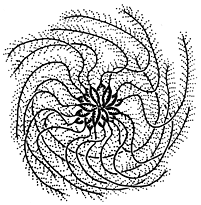
Description: Mostly woody climbers with twining petioles and petiolules, perennial, evergreen [or deciduous], often dioecious.
Leaves opposite, simple or compound and then pinnately or ternately divided 1–3 times.
Flowers in paniculate inflorescences [or solitary and axillary or terminal], actinomorphic, unisexual [or bisexual]. Sepals 4 or rarely more, petaloid, valvate, white or reddish [or blue or yellow]. Petals absent [or minute]. Stamens many, petaloid staminodes sometimes present. Carpels many.
Fruit a globose head of achenes, each with a persistent, elongated, often plumose style.
Distribution and occurrence: World: c. 250–300 species, northern & southern temperate regions. Australia: 8–10 species (1 species naturalized), all States except N.T.
The term 'flammuliform' is used in the key below to describe the complicated division of leaves of some species where the leaf is cleft into 5 primary divisions, which are then ternately divided. This leads to a typical condition of 15 leaflets, but by further or incomplete division, there may as few as 12 or as many as 36 leaflets. The term is derived from Clematis flammula whose leaves demonstrate this type of division. Hj.Eichler, J.A.Jeanes (2020) Clematis. In: Flora of Australia. Australian Biological Resources Study, Department of Agriculture, Water and the Environment, Canberra. https://profiles.ala.org.au/opus/foa/profile/Clematis [Date Accessed: 20 February 2020]
Text by B. G. Briggs & R. O. Makinson
Taxon concept:
| | Key to the species | |
| 1 | Leaves simple to ternate or imparipinnate, with 5(-7) or fewer leaflets, anthers with or without an apically protruding connective appendage | 2 |
| Leaves biternate, triternate or flammuliform with more than 5 leaflets; anthers without an apically protuding connective appendage | 5 |
| 2 | Plants deciduous with bisexual flowers | Clematis montana |
| Plants evergreen, dioecious; (female flowers with one whorl of staminodes)
Back to 1 | 3 |
| 3 | Leaf margins usually entire; connective appendage to 0.5 mm long; tepals 0.7–2.5 cm long | 4 |
| Leaf margins serrate;connective appendages 1–3 mm long; tepals 1.3–3.5 cm long
Back to 2 | Clematis aristata |
| 4 | Achenes often with distinct longitudinal ridges on each lateral face, often more or less falcate, tepals 0.7–1.6 cm long; anthers mostly 1–1.5 mm long; connective appendage 0.2–0.5 mm long | Clematis pickeringii |
| Achenes neither ridged nor falcate; tepals 1.1–2.5 cm long; anthers mostly 1.5–2 mm long, connective appendage 0.2–0.5 mm long
Back to 3 | Clematis glycinoides |
| 5 | Achenes fusiform. c. 1 mm diameter; leaflets usually serrate-dentate | Clematis fawcettii |
| Achenes distictly compressed, broader than 1 mm, leaflets usually entire ot sometimes deeply lobed
Back to 1 | 6 |
| 6 | Leaflets usually biternate with up to 9(-12) leaflets, sometimes with leaflets lobed | Clematis microphylla |
| Leaves flammuliform to triternate with more than 12 leaflets (rarely fewer in some immature leaves)
Back to 5 | 7 |
| 7 | Leaflets usually 12–15 per leaf, broadest below the middle; terminal leaflet 12–45 mm long | Clematis decipiens |
| Leaflets usually 18–36 per leaf, broadest beyond the middle towards the leaf tips; terminal leaflet 5–15 (-25) mm long
Back to 6 | Clematis leptophylla |
|


